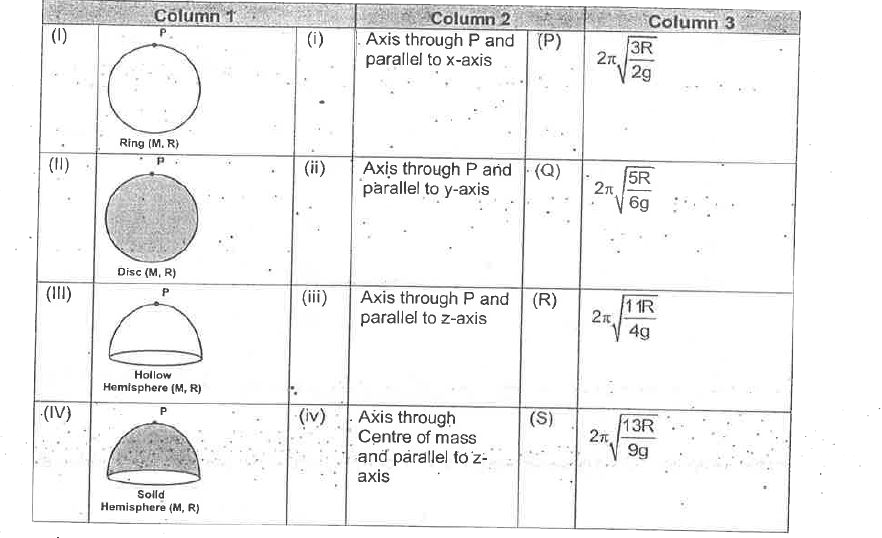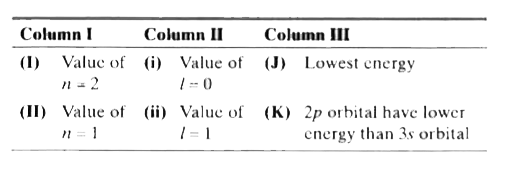The following situation regards the physical pendulum. Column-1 gives the different types of bodies. Column -2 gives the different axes about which they can possibly perform SHM. Column-3 gives possible time periods. (The plane of the four figure is the vertical plane)


Pick correct option
(I) (ii) (S)
(II) (ii) (P)
(I) (ii) (R )
(IV) (i) (Q)
The correct Answer is:B
Topper's Solved these Questions
- SIMPLE HARMONIC MOTIONBOOK - FIITJEECHAPTER - SIMPLE HARMONIC MOTIONEXERCISE - Exercise
28 Videos
- SIMPLE HARMONIC MOTIONBOOK - FIITJEECHAPTER - SIMPLE HARMONIC MOTIONEXERCISE - Assignment Problems (Subjective) (Level)
20 Videos
- SIMPLE HARMONIC MOTIONBOOK - FIITJEECHAPTER - SIMPLE HARMONIC MOTIONEXERCISE - Numerical Based Questions
6 Videos
- SEMICONDUCTOR AND DEVICEBOOK - FIITJEECHAPTER - SEMICONDUCTOR AND DEVICEEXERCISE - SOLVED PROBLEMS Objective: Level-I
20 Videos
- TEST PAPERSBOOK - FIITJEECHAPTER - TEST PAPERSEXERCISE - PHYSICS
747 Videos
Similar Questions
Column-1 shows certain situations with certain conditions and column-2 shows the parameters in which situations of column-1 match. Which can be possible combination.

View SolutionColumn-1 shows certain situations with certain conditions and column-2 shows the parameters in which situations of column-1 match. Which can be possible combination.


View Solution
Knowledge Check
The following situation regards the physical pendulum. Column-1 gives the different types of bodies. Column -2 gives the different axes about which they can possibly perform SHM. Column-3 gives possible time periods. (The plane of the four figure is the vertical plane)


Pick the option for minimum value of VAA(I) (ii) (P)B(II) (i) (R )C(III (iv) (Q)D(II) (iii) (S)Column-I gives different situtions in which bodes are floating in liquid. Column-II gives correspoding time periods of oscillation.
_E01_069_Q01.png)
A cube floating in liquid.APQRS(A)3421BPQRS(B)1342CPQRS(C)2314DPQRS(D)4321In each equation, there is a table having 3 columns and 4 rows. Based on the table, there are 3 questions. Each question has 4 options (a), (b), (c ) and (d), ONLY ONE of these four options is correct.
There are different types of lasers. In the given table, Colums I shows the properties of different lasers or material used in lasers, Column II shows the different names of the lasers and Column III shows the uses of different type of lasers.

What are the characteristics of semiconductor laser?A(I) (iii) (K)B(IV) (iii) (J)C(I) (ii) (M)D(II) (i) (K)
Column-1 shows certain situations with certain conditions and column-2 shows the parameters in which situations of column-1 match. Which can be possible combination.


View SolutionBernoulli’s equation can be written in the following different forms (Column I). Column II lists certain units each of which pertains to one of the possible forms of the equation. Match the unit associated with each of the following:

View SolutionIn each equation, there is a table having 3 columns and 4 rows. Based on the table, there are 3 questions. Each question has 4 options (a), (b), (c ) and (d), ONLY ONE of these four options is correct.
Four quantum numbers shows the electronic configuration of the element. In the given table, Column I shows the different values of principal quantum number, Column II shows the different values of angular momentum quantum number and Column III shows the energy levels for different orbitals.


What are the characteristics of 1s orbital?
View SolutionIn each equation, there is a table having 3 columns and 4 rows. Based on the table, there are 3 questions. Each question has 4 options (a), (b), (c ) and (d), ONLY ONE of these four options is correct.
Four quantum numbers shows the electronic configuration of the element. In the given table, Column I shows the different values of principal quantum number, Column II shows the different values of angular momentum quantum number and Column III shows the energy levels for different orbitals.


What are the characteristics of 2s orbital?
View SolutionIn each equation, there is a table having 3 columns and 4 rows. Based on the table, there are 3 questions. Each question has 4 options (a), (b), (c ) and (d), ONLY ONE of these four options is correct.
Four quantum numbers shows the electronic configuration of the element. In the given table, Column I shows the different values of principal quantum number, Column II shows the different values of angular momentum quantum number and Column III shows the energy levels for different orbitals.


What are the characteristics of 2p orbital?
View Solution
